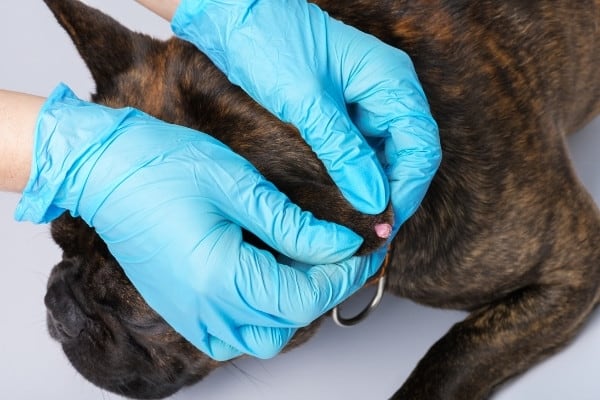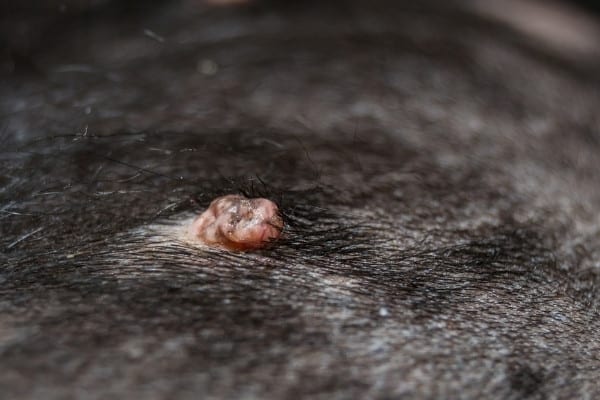
Many pet owners have dealt with canine warts. They often appear suddenly and can last for several months. While they are rarely painful, they can be uncomfortable for some dogs.
Understanding how warts develop and how to treat them will allow you to keep your dog healthy and enjoy more quality time with your pet.
How do dogs get warts? Dog warts are caused by the canine papillomavirus. The contagious virus is contracted from other dogs. Elderly dogs, puppies, and dogs with weakened immune systems may develop canine warts as a reaction to the virus, but healthy dogs with strong immune systems are not likely to develop them.
If you think your dog may have canine warts or if you are worried that he or she may develop them in the future, read on to learn more about the condition.
Understanding Dog Warts
Dog warts can appear as small growths on one or more areas of the body. While they are unsightly, they are usually not cause for concern. Understanding how and why dogs develop warts can help you determine if a veterinary appointment is needed.
Why Does a Dog Get Warts?
Dogs get warts when they contract a virus called papillomavirus.
This type of virus is considered an opportunistic virus and usually attacks a dog when the immune system is already compromised due to another illness or infection.
Dogs are exposed to this virus pretty often, but it can only establish itself if the dog has a lowered immune system.
How To Identify Warts on Dogs
Warts appear as growths on the dog’s body. Warts can be rounded, cauliflower shaped, or oblong. They are usually raised but may start out as flat growths.
They are typically skin-colored but may be covered by fur and hard to see. They can grow individually in one or more areas or may grow in patches in one general area.
Where Dog Warts Are Most Likely To Appear
Dogs can get warts on any area of the body, but they are more likely to grow around the dog’s mouth, ears, and on their feet.
They can also grow between the toes and cause pain or discomfort while walking.
When Dog Warts Are Most Likely To Develop
Warts can occur on dogs of all ages, but dogs who are older are more likely to have weakened or compromised immune systems and therefore are more susceptible to the virus.
Puppies under the age of two are also more susceptible as their immune systems are not fully developed and may not be able to fight off the virus.
How Long Do Warts on Dogs Last?
Warts can last on dogs for up to six months, depending on the area of the body where they are present.
Warts do not spread to other areas of the body, and most resolve themselves within two months.
Dogs who are taking immunosuppressive medications or are ill may not be able to get over the infection on their own and may require medical treatment.
Are Dog Warts Painful? Itchy?
Dog warts are not often painful or itchy, but they can be bothersome.
Depending on the location, warts can be rubbed or scratched against things that could cause them to break open and bleed. This could lead to them becoming painful or infected.
Infections can be dangerous and may require medical treatment.
Can Dog Warts Be Cancerous?
While dog warts caused by the papillomavirus are not likely to turn cancerous, cancer can look like warts.
Cancerous growths are usually firm to touch and grow much larger than warts caused by the papillomavirus. They can be flat or odd-shaped and are more likely to grow larger over time.
Will Dog Warts Go Away on Their Own?

Warts usually go away on their own if a dog is healthy. Dogs who have compromised immune systems, younger dogs, and elderly dogs may take longer to get over their warts.
If the warts are bleeding or are infected, it may be necessary to take your dog to the vet. In rare instances, warts may actually be small tumors.
A veterinarian will be able to take a sample scraping of the warts to determine their cause and come up with the right treatment plan.
Are There Different Types of Dog Warts?
There are different types of dog warts. Some warts are congenital, meaning they are passed onto dogs through genetics while in the womb. Others are contracted as a virus.
There are three different kinds of viral dog warts: mucous membrane papillomatosis, cutaneous papillomas, and cutaneous inverted papillomas.
They all look very similar, but a veterinarian can diagnose the different types.
Are Warts on Dogs Contagious to Humans?
Viral dog warts can spread to other dogs, but they cannot spread to humans or other animals. Dog warts are caused by the canine papillomavirus, which is not contagious to humans.
Are Dog Warts Contagious to Other Dogs?
Dog warts are contagious to other dogs. Most dogs are exposed to the canine papillomavirus many times in their lifetimes.
While they may contract the virus, it doesn’t necessarily mean they will get warts. If the immune system is strong, it will be able to fight the virus, and the virus will not affect them.
Can Dogs Get Warts From Humans?
No, the virus that causes human warts cannot be spread to dogs. Dog warts are caused by the canine papillomavirus, which can only be spread among dogs.
Dog Wart Bleeding
Warts are usually not cause for concern and will often resolve themselves.
If your dog has warts that are bleeding, it likely means they have been scratched or rubbed against something. This can lead to an infection.
You can treat the wart by using alcohol to clean the area and applying triple antibiotic cream (check out the great price on this pack of four) to the wart.
If the warts are bleeding profusely or if they continue to bleed, you may need to take your dog to the vet.
Puppy Warts
Puppies are often susceptible to warts because their immune systems are not fully developed and they cannot fight the virus.
As the puppy gets older, its immune system will grow stronger, and the warts should resolve themselves.
If the puppy seems to be getting sick or if the warts become infected, you may need to take the puppy to the veterinarian for treatment.
Dog Wart Treatment
Warts usually resolve themselves within a couple of months.
If this isn’t the case for your dog or if you don’t want to wait for the warts to go away on their own, there are some treatment options to consider:
- Cryogenic removal
- Surgical excision
- Laser surgery
- Steroid injections
- Topical steroid creams
- Antibiotics
How To Prevent Dog Warts
Dogs develop warts after being infected with the canine papillomavirus.
The only way to prevent warts from developing is to avoid exposure to other dogs and keep the immune system strong through proper nutrition and exercise.
Healthy dogs are less likely to develop warts as a response to the virus. Regular veterinary checkups can help keep your dog healthy and may prevent canine warts.
Related Questions:
Why Do Dogs Get Warts When They Get Old?
As dogs age, their immune systems become compromised and weakened. They are not able to fight the canine papillomavirus and are more likely to develop warts as a reaction to it.
How Much Does It Cost To Remove a Wart From a Dog?
Dog wart removal can cost between $80 and $400. The location of the warts, their severity, and the preferred removal method can affect the total cost.
Conclusion
Dog warts are caused by the canine papillomavirus and are fairly common. While most dogs come in contact with this virus many times in their lives, most will not develop warts.
Keeping your dog healthy and avoiding unnecessary contact with other dogs can help prevent the spread of the virus and the development of warts.
Last update on 2024-04-26 at 01:56 / Affiliate links / Images from Amazon Product Advertising API

![MED PRIDE Triple Antibiotic Ointment [1 oz] 4-Pack...](https://m.media-amazon.com/images/I/51NcDFk4dlL.jpg)



